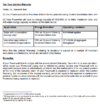Just curious what is the % degradation of PW especially for those who have it for several years.
I have my PW+ for 21 months and it's mounted outdoor. I'm on TOU and usually drain it to 10% or less daily. So far, the app is telling me there's only 1% degradation.
I have my PW+ for 21 months and it's mounted outdoor. I'm on TOU and usually drain it to 10% or less daily. So far, the app is telling me there's only 1% degradation.



